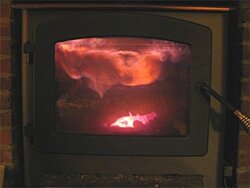I think I've got this worked out. This AM I drove 90 miles to borrow my dad's draft gauge. Built another fire, and about 20 minutes into it, the draft measured .07 inches of water, above the flue collar. The Englander design is for .06 to .08 inches of water, so it's pretty clear now that the draft is not the problem.
This fire I built like an inverted V, with the pieces pointing toward the middle of the back wall of the stove.Initially, fire burning great with door cracked, subdued with door sealed. Temps 450-500 like yesterday. At this point, there were 4 splits in the box, each about 4 inches diameter. On a whim, I decided to fill up the firebox. Put in 4 more splits, still in an inverted V (roughly).
It took off. Fire was so big I had to seal the door. Temps now around 550. But no secondary burn.
So I started to slowly close the air inlet. About half-way in, massive secondary burn appeared. Stove temps 550-600. Temp at pipe entering wall 310-320 by IR gun.
No problems after that. Withe air inlet mostly open, no smoke seen at the chimney. With air inlet fully closed though, slight white smoke. I think that is normal?
So in the end, the problem appears to have been not due to wet wood or poor draft. It was either the geometry of the fire I was building, or that it wasn't large enough a fire--not too cold, just too small.
But I learned a lot troubleshooting this problem. Thanks to all who contributed.
This fire I built like an inverted V, with the pieces pointing toward the middle of the back wall of the stove.Initially, fire burning great with door cracked, subdued with door sealed. Temps 450-500 like yesterday. At this point, there were 4 splits in the box, each about 4 inches diameter. On a whim, I decided to fill up the firebox. Put in 4 more splits, still in an inverted V (roughly).
It took off. Fire was so big I had to seal the door. Temps now around 550. But no secondary burn.
So I started to slowly close the air inlet. About half-way in, massive secondary burn appeared. Stove temps 550-600. Temp at pipe entering wall 310-320 by IR gun.
No problems after that. Withe air inlet mostly open, no smoke seen at the chimney. With air inlet fully closed though, slight white smoke. I think that is normal?
So in the end, the problem appears to have been not due to wet wood or poor draft. It was either the geometry of the fire I was building, or that it wasn't large enough a fire--not too cold, just too small.
But I learned a lot troubleshooting this problem. Thanks to all who contributed.


